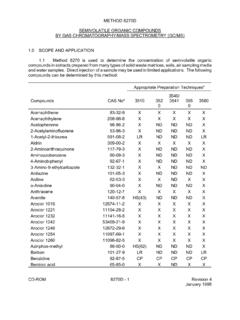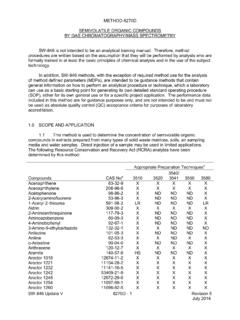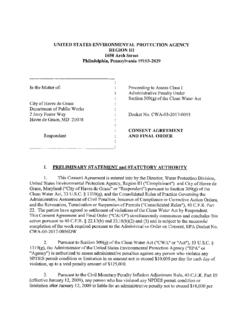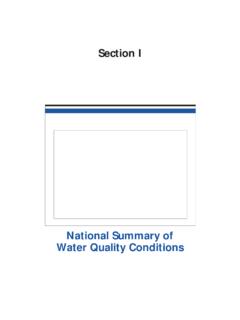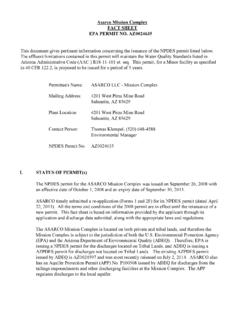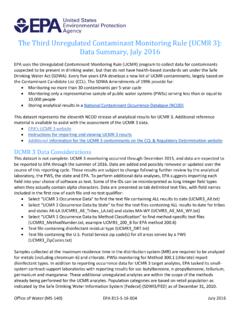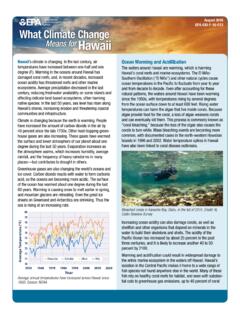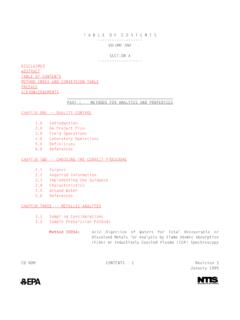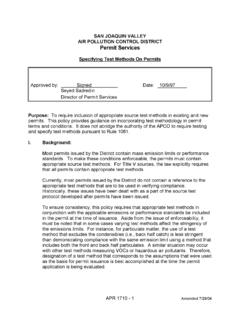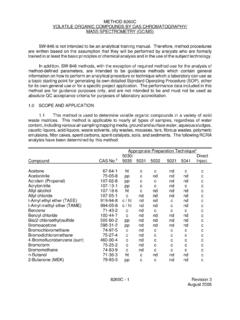Transcription of METHOD 8260B VOLATILE ORGANIC COMPOUNDS BY GAS ...
1 CD-ROM8260B - 1 Revision 2 December 1996 METHOD 8260 BVOLATILE ORGANIC COMPOUNDS BY GAS CHROMATOGRAPHY/MASS SPECTROMETRY (GC/MS) AND 8260 is used to determine VOLATILE ORGANIC COMPOUNDS in a variety of solid wastematrices. This METHOD is applicable to nearly all types of samples, regardless of water content,including various air sampling trapping media, ground and surface water, aqueous sludges, causticliquors, acid liquors, waste solvents, oily wastes, mousses, tars, fibrous wastes, polymericemulsions, filter cakes, spent carbons, spent catalysts, soils, and sediments. The followingcompounds can be determined by this METHOD .
2 Appropriate Preparation Techniquea 5030/DirectCompoundCAS (Propenal)107-02-8ppccndndcAcrylonitrile 107-13-1ppccndccAllyl alcohol107-18-6htcndndndcAllyl chloride107-05-1cndndndndcBenzene71-43-2 cndccccBenzyl chloride100-44-7cndndndndcBis(2-chloroet hyl)sulfide505-60-2ppndndndndcBromoaceto ne598-31-2ppndndndndcBromochloromethane 74-97-5cndccccBromodichloromethane75-27- 4cndcccc4-Bromofluorobenzene (surr)460-00-4cndccccBromoform75-25-2cnd ccccBromomethane74-83-9cndccccn-Butanol7 1-36-3htcndndndc2-Butanone (MEK)78-93-3ppccndndct-Butyl alcohol75-65-0ppcndndndcCarbon disulfide75-15-0ppndcndccCarbon tetrachloride56-23-5cndccccChloral hydrate302-17-0ppndndndndcChlorobenzene1 08-90-7cndccccChlorobenzene-d (IS)cndcccc5 Chlorodibromomethane124-48-1cndcndccChlo roethane75-00-3cndcccc2-Chloroethanol107 -07-3ppndndndndc2-Chloroethyl vinyl ether110-75-8cndcndndcChloroform67-66-3c ndccccChloromethane 74-87-3cndccccChloroprene 126-99-8cndndndndc3-Chloropropionitrile5 42-76-7 Indndndndpc(continued)
3 CD-ROM8260B - 2 Revision 2 December 1996 Appropriate Preparation Techniquea 5030/DirectCompoundCAS ,2-Dibromo-3-chloropropane96-12-8ppndndc ndc1,2-Dibromoethane106-93-4cndndcndcDib romomethane74-95-3cndcccc1,2-Dichloroben zene95-50-1cndndcndc1,3-Dichlorobenzene5 41-73-1cndndcndc1,4-Dichlorobenzene106-4 6-7cndndcndc1,4-Dichlorobenzene-d (IS)cndndcndc4cis-1,4-Dichloro-2-butene1 476-11-5cndcndndctrans-1,4-Dichloro-2-bu tene110-57-6ppndcndndcDichlorodifluorome thane75-71-8cndccndc1,1-Dichloroethane75 -34-3cndcccc1,2-Dichloroethane107-06-2cn dcccc1,2-Dichloroethane-d (surr)cndcccc41,1-Dichloroethene75-35-4c ndcccctrans-1,2-Dichloroethene156-60-5cn dcccc1,2-Dichloropropane78-87-5cndcccc1, 3-Dichloro-2-propanol96-23-1ppndndndndcc is-1,3-Dichloropropene10061-01-5cndcndcc trans-1,3-Dichloropropene10061-02-6cndcn dcc1,2,3,4-Diepoxybutane1464-53-5cndndnd ndcDiethyl ether60-29-7cndndndndc1,4-Difluorobenzen e (IS)540-36-3ndndndndcnd1,4-Dioxane123-91 -1ppccndndcEpichlorohydrin106-89-8 IndndndndcEthanol64-17-5 IccndndcEthyl acetate141-78-6 IcndndndcEthylbenzene100-41-4cndccccEthy lene oxide75-21-8ppcndndndcEthyl methacrylate97-63-2cndcndndcFluorobenzen e (IS)
4 462-06-6cndndndndndHexachlorobutadiene87 -68-3cndndcndcHexachloroethane67-72-1 Indndndndc2-Hexanone591-78-6ppndcndndc2- Hydroxypropionitrile78-97-7 IndndndndpcIodomethane74-88-4cndcndccIso butyl alcohol78-83-1ppcndndndcIsopropylbenzene 98-82-8cndndcndcMalononitrile109-77-3ppn dndndndcMethacrylonitrile126-98-7ppIndnd ndcMethanol67-56-1 IcndndndcMethylene chloride75-09-2cndccccMethyl methacrylate80-62-6cndndndndc4-Methyl-2- pentanone (MIBK)108-10-1ppccndndcNaphthalene91-20- 3cndndcndc(continued)CD-ROM8260B - 3 Revision 2 December 1996 Appropriate Preparation Techniquea 5030/DirectCompoundCAS alcohol107-19-7ppIndndndc$-Propiolactone 57-57-8ppndndndndcPropionitrile (ethyl cyanide)107-12-0htcndndndpcn-Propylamine 107-10-8cndndndndcPyridine110-86-1 IcndndndcStyrene100-42-5cndcccc1,1,1,2-T etrachloroethane630-20-6cndndccc1,1,2,2- Tetrachloroethane79-34-5cndccccTetrachlo roethene127-18-4cndccccToluene108-88-3cn dccccToluene-d (surr)
5 2037-26-5cndcccc8o-Toluidine95-53-4ppcnd ndndc1,2,4-Trichlorobenzene120-82-1cndnd cndc1,1,1-Trichloroethane71-55-6cndcccc1 ,1,2-Trichloroethane79-00-5cndccccTrichl oroethene79-01-6cndccccTrichlorofluorome thane75-69-4cndcccc1,2,3-Trichloropropan e96-18-4cndccccVinyl acetate108-05-4cndcndndcVinyl chloride75-01-4cndcccco-Xylene95-47-6cnd ccccm-Xylene108-38-3cndccccp-Xylene106-4 2-3cndcccc See Sec. for other appropriate sample preparation techniquesa Chemical Abstract Service Registry Numberbc=Adequate response by this techniqueht= METHOD analyte only when purged at 80 ECnd=Not determinedI=Inappropriate technique for this analytepc=Poor chromatographic behaviorpp=Poor purging efficiency resulting in high Estimated Quantitation Limitssurr=SurrogateIS=Internal StandardCD-ROM8260B - 4 Revision 2 December are various techniques by which these COMPOUNDS may be introduced into theGC/MS system.
6 The more common techniques are listed in the table above. Purge-and-trap, byMethods 5030 (aqueous samples) and 5035 (solid and waste oil samples), is the most commonlyused technique for VOLATILE ORGANIC analytes. However, other techniques are also appropriate andnecessary for some analytes. These include direct injection following dilution with hexadecane( METHOD 3585) for waste oil samples; automated static headspace by METHOD 5021 for solidsamples; direct injection of an aqueous sample (concentration permitting) or injection of a sampleconcentrated by azeotropic distillation ( METHOD 5031); and closed system vacuum distillation (Method5032) for aqueous, solid, oil and tissue samples.
7 For air samples, METHOD 5041 providesmethodology for desorbing VOLATILE organics from trapping media ( methods 0010, 0030, and 0031).In addition, direct analysis utilizing a sample loop is used for sub-sampling from Tedlar bags( METHOD 0040). METHOD 5000 provides more general information on the selection of the appropriateintroduction 8260 can be used to quantitate most VOLATILE ORGANIC COMPOUNDS that haveboiling points below 200EC. VOLATILE , water soluble COMPOUNDS can be included in this analyticaltechnique by the use of azeotropic distillation or closed-system vacuum distillation.
8 Suchcompounds include low molecular weight halogenated hydrocarbons, aromatics, ketones, nitriles,acetates, acrylates, ethers, and sulfides. See Tables 1 and 2 for analytes and retention times thathave been evaluated on a purge-and-trap GC/MS system. Also, the METHOD detection limits for 25-mL sample volumes are presented. The following COMPOUNDS are also amenable to analysis byMethod 8260:Bromobenzene1,3-Dichloropropanen-Bu tylbenzene2,2-Dichloropropanesec-Butylbe nzene1,1-Dichloropropenetert-Butylbenzen ep-IsopropyltolueneChloroacetonitrileMet hyl acrylate1-ChlorobutaneMethyl-t-butyl ether1-ChlorohexanePentafluorobenzene2-C hlorotoluenen-Propylbenzene4-Chlorotolue ne1,2,3-TrichlorobenzeneDibromofluoromet hane1,2,4-Trimethylbenzenecis-1,2-Dichlo roethene1,3, estimated quantitation limit (EQL) of METHOD 8260 for an individual compound issomewhat instrument dependent and also dependent on the choice of samplepreparation/introduction METHOD .
9 Using standard quadrapole instrumentation and the purge-and-traptechnique, limits should be approximately 5 g/kg (wet weight) for soil/sediment samples, mg/kg(wet weight) for wastes, and 5 g/L for ground water (see Table 3). Somewhat lower limits may beachieved using an ion trap mass spectrometer or other instrumentation of improved design. Nomatter which instrument is used, EQLs will be proportionately higher for sample extracts andsamples that require dilution or when a reduced sample size is used to avoid saturation of METHOD is restricted to use by, or under the supervision of, analysts experienced inthe use of gas chromatograph/mass spectrometers, and skilled in the interpretation of mass spectraand their use as a quantitative - 5 Revision 2 December OF VOLATILE COMPOUNDS are introduced into the gas chromatograph by the purge-and-trapmethod or by other methods (see Sec.)
10 The analytes are introduced directly to a wide-borecapillary column or cryofocussed on a capillary pre-column before being flash evaporated to anarrow-bore capillary for analysis. The column is temperature-programmed to separate the analytes,which are then detected with a mass spectrometer (MS) interfaced to the gas chromatograph (GC). eluted from the capillary column are introduced into the mass spectrometer viaa jet separator or a direct connection. (Wide-bore capillary columns normally require a jet separator,whereas narrow-bore capillary columns may be directly interfaced to the ion source).
